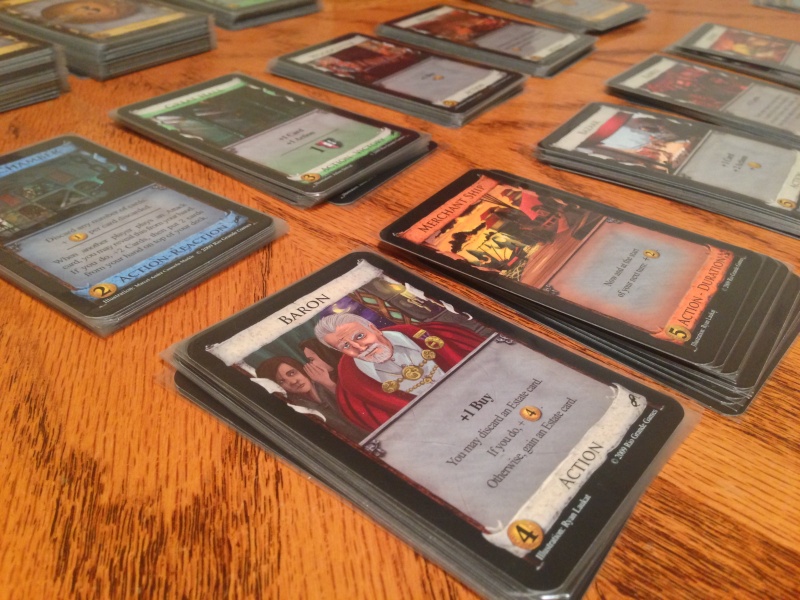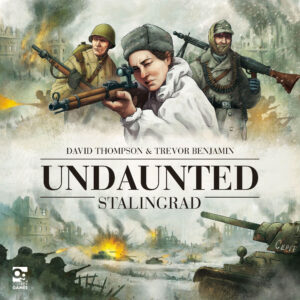 David Thompson & Trevor Benjamin. Osprey Games. Another game in the Undaunted deck-building series. This one a significant narrative campaign. Set in Stalingrad, one of the bloodiest battles in human history.
David Thompson & Trevor Benjamin. Osprey Games. Another game in the Undaunted deck-building series. This one a significant narrative campaign. Set in Stalingrad, one of the bloodiest battles in human history.
With significant choice, heart-wrenching losses, glorious victory, and plenty of surprises, I can only ask one thing: When and where do I enlist???
Gameplay Overview:
Two players enter this one-versus-one campaign. Each is given a scenario book specifically for their faction (Soviets or Germans), their own card supply comprised of starting, reserve, upgrade, and locked cards. There are also faction specific tokens and 100+ location tiles that represent the city of Stalingrad.
For those who’ve not played the Undaunted series, here’s a brief overview of what you do on your turn: you play cards to send soldiers to their doom, repeatedly. That’s true, but everything is based on card play. During a turn, players draw four cards and determine one to use for initiative. Each card has an initiative value and whichever faction chooses the highest number goes first. The remaining three cards determine which units can perform a single-card action, flip from suppressed to ready, or hunker down (return to supply). The player with initiative plays all cards first, then the other player plays their cards. After this, the cycle continues with card draw and sacrificing one card to bid for initiative.
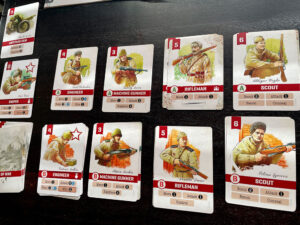
Each faction has a baseline deck that is practically the same but has a supply of available soldier and vehicle cards to add to their deck via a specific action chosen when playing their platoon sergeant card. The entire game is determined by how players draw and perform their actions. The one wrinkle is that there are two fog of war cards in the starting deck (more may be added later) that cannot be played and change the tempo on occasion. (Fog of War cards are basically useless, clogging up your hand other than as low bids for initiative.)
Movement and combat occur on a predetermined map comprised of tiles that feature defense and cover bonuses as well as significant landmarks. Stalingrad features the ability to destroy buildings and replace tiles, which carries forward to future missions. Combat is completed with a dice roll based on the attacker’s power value, their distance from the enemy, and the cover bonus on the enemy tile.
Upon a successful attack (and rolling a zero is an auto success) the faction that suffered the loss must discard a copy of a card of that specific unit into a casualty pile. Which card is removed is based on whether the faction has already played or not. Once all cards from that unit are out of play and it receives another casualty, the unit is routed and cannot be utilized until bolstered by a squad leader or platoon sergeant. In many missions, routing all the enemy’s rifleman units results in an instant win.
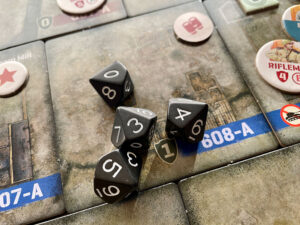
Stalingrad’s campaign can span fifteen games. Over the course of this campaign, players try to meet objectives, and upon completion of a mission, read a briefing from their scenario book before moving on. Each mission setup may introduce new faction units as well as new rules and conditions. It also begins to make each faction more defined and asymmetric.
Asymmetry also comes in the form of casualties and upgrades. After a mission is complete, each faction must discard a certain number of cards from their casualty pile. These are replaced by reserve cards if they are your baseline units, though other unit types may be lost for the remainder of the campaign. After determining casualties, each faction randomly draws two units to upgrade. Not all units can be upgraded, but those that can will gain new abilities or get their base-level actions boosted. Thus upgraded units become more coveted on the battlefield.
There’s a lot more to learn about within, but I don’t want to spoil this campaign. There are many actions to discover, new units to explore, and the campaign continually introduces new elements for you to learn. This campaign also allows players to reset it once finished, as it is not a legacy game. This allows for unlimited plays through the campaign and exploration of its many branching narratives and endings.
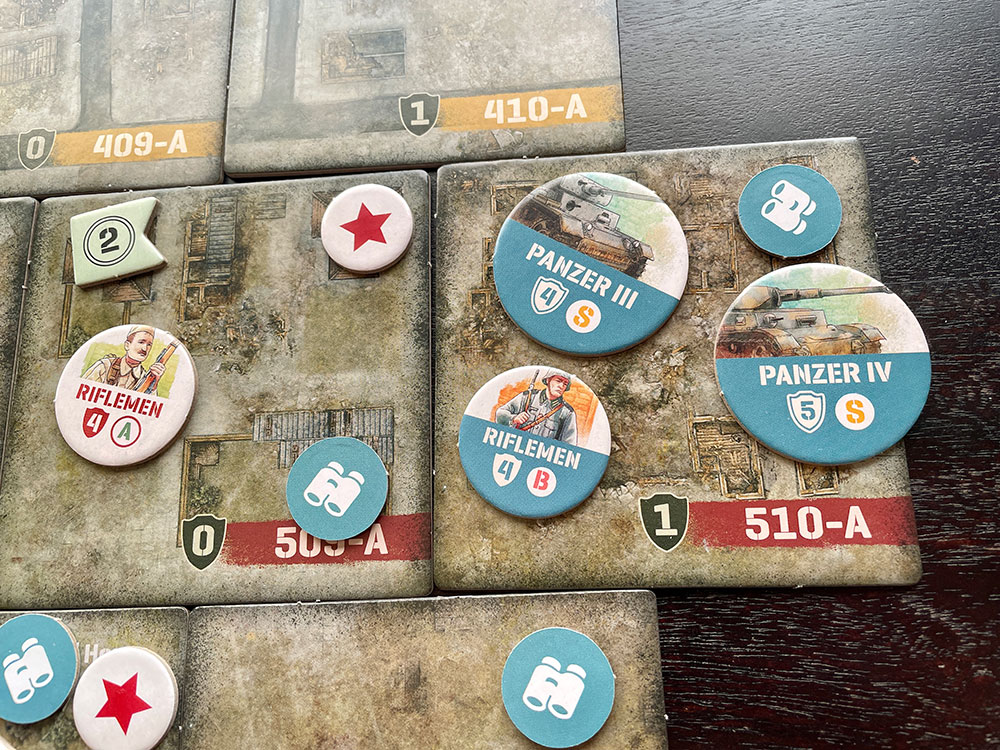
Game Experience:
This is my first Undaunted experience. It won’t be my last. The deckbuilding is excellent, and the campaign setting provides a brutal reality of war as your units slowly dwindle to the point of being a platoon full of reserves. And the reserves never go away. They just keep coming back for more punishment. Looking at my casualty pile at the end of the campaign was a harsh reminder of the horrors of war.
The campaign provides a lot of excellent variety. This is mostly provided by continually ramping up the ruleset as time progresses. Not all objectives are as varied, but in a battle of inching out control of a region, the simulation has a very thematic grounding. Blowing up an enemy building, only to push into that space with no cover in the next scenario, is a rough actuality to grapple with. So even with similar tiles being explored over the course of the fifteen missions, things do change.

The campaign balance felt great as well. It always felt like a tug of war between two factions and while there may be consecutive missions with the same winner, the other side has plenty of time to recover ground via the branching mission structure. In my first campaign, the Soviets won nine missions to the Germans six. It helps that there is a withdraw option so that if you feel like your units are struggling, you can get them out of harm’s way to suffer fewer casualties in the loss. By the end, both sides’ reserve decks were nearly depleted.
This is also a very easy campaign to navigate. Everything is laid out nicely and steps both before and after a mission are easy to complete. The only daunting moment is adding all the tokens to the board as shown by the map book. But with players each focusing on their own side, it doesn’t take very long. The rulebook lays out combat and new tokens nicely, and each action is easy to refer to if you find you need to relearn anything.
I’ve read that Stalingrad changes a couple of mechanisms from earlier games in the series. The routing of units felt natural to me and made me constantly mindful of my unit numbers. The rules to how units spawn to the board is also updated in this iteration of Undaunted. Rather than set locations, units enter the board based on rifleman locations. Riflemen become important as they are also the unit that can control mission points and push to victory in several mission types.
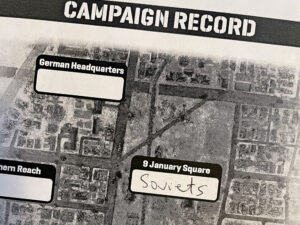
The casualty system is also brilliant and heartbreaking. I had a real connection with a rifleman and a machine gunner who were stars of my platoon. When I lost the rifleman after pushing too hard, and then drawing them after the mission when they were, sadly, in the casualty pile, I immediately regretted the decision to rush. Connection to specific characters began to occur over time. And the unique artwork by Roland MacDonald only added to the buy-in.
The areas that tripped me up were few and far between. The narration between missions provides insight into the platoon leaders and the upcoming battles, but it never truly pulled me in. On future plays, I may just skip to the end without reading the narration. The writing isn’t bad, it just doesn’t have time to develop, and I became much more interested in my combat units as they were the ones facing death’s door. The other area that I wish were more developed is the map tile illustration. The tiles are a little muted, and while everything feels awash in mud and dirt, it’s also hard to see everything that your units are navigating. A missed opportunity.
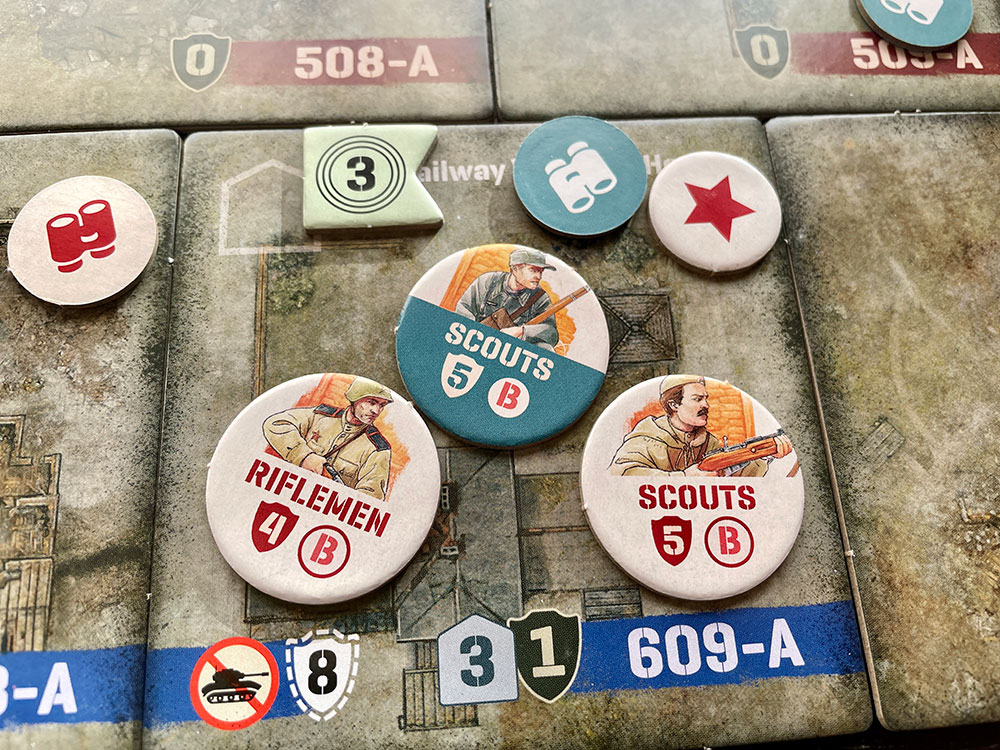
Final Thoughts:
If I’d played Undaunted Stalingrad before the end of 2022, it would’ve placed as my number two game of the year. I can’t wait to dive into future campaigns, switching between factions, trying new tactics, and trying to preserve some of my favorite units. There’s so much to enjoy with this system – it may be one of the best deck builders out there. The only caveat I’d provide is that those who are not too keen on war settings may not find this appealing, though I’d challenge anyone to give this card system a try before turning away from this series.
Final Score: 4.5 stars – Achtung! Gather courage and enter the arena of brutal combat and top-notch gameplay.
 Hits:
Hits:
• Superb deckbuilding
• Choices have consequences
• Campaign reflects desperate battle
• Terrain destruction
• Casualties and upgrades
Misses:
• Narration feels isolated
• Tiles lack definition







